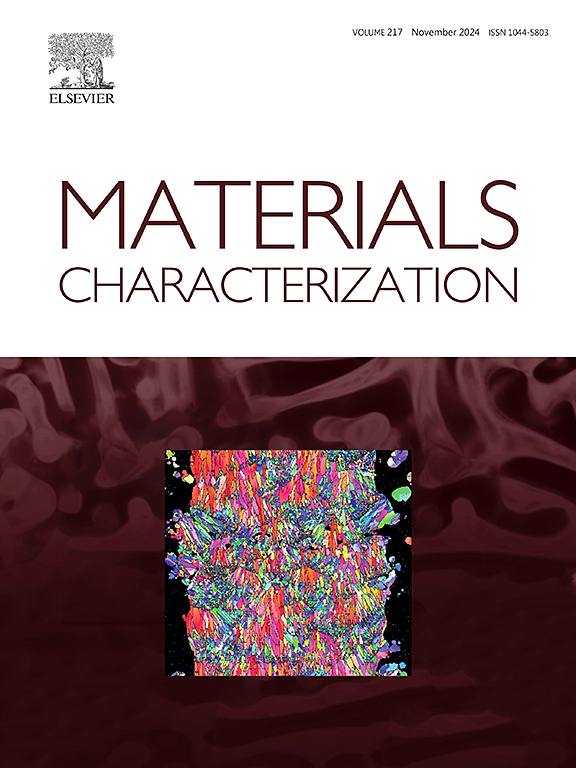低温与室温轧制相结合策略对高温合金箔强度与塑性协同增强机理的研究
IF 4.8
2区 材料科学
Q1 MATERIALS SCIENCE, CHARACTERIZATION & TESTING
引用次数: 0
摘要
本研究提出了一种新的铝箔制备方法,采用低温轧制和室温轧制相结合的策略,并结合短时间退火处理,以达到强度和塑性的良好协同。与完全室温轧制得到的箔相比,加入低温轧制工艺使样品在1000℃退火时的屈服强度从493 MPa提高到563 MPa,在不牺牲塑性的情况下获得了优异的强度(12.33%)。在950℃退火后,样品表现出优异的屈服强度(670 MPa)、抗拉强度(1023 MPa)和伸长率(14.1%)。各阶段的显微组织表征表明,低温轧制过程有效地延缓了位错的动态恢复,限制了位错的运动。剧烈塑性变形使晶界增大,减少了位错的平均路径,促进了位错的相互作用。同时,缺陷的增加促进了δ相的析出,增加了位错的阻碍作用,钉住了晶界,获得了细晶组织。此外,变形孪晶、分层SFs和lomo -cottrell (L-C)锁的协同效应以及它们之间广泛的相互作用有助于增强变形抗力,这在室温轧制箔中很少观察到。对于完全室温轧制的铝箔,变形程度的降低减弱了缺陷和δ相的形成。变形不均匀导致短时间退火后局部区域晶粒生长异常,力学性能较差。该研究为箔的制备和微结构调控提供了新的思路。本文章由计算机程序翻译,如有差异,请以英文原文为准。
Synergy enhancement mechanism of strength and plasticity for superalloy foil by a strategy combining cryogenic and room-temperature rolling
In this study, a new method of foil preparation is proposed, adopting a strategy combining cryogenic rolling and room-temperature rolling, together with a short-time annealing treatment to achieve a superior synergy in strength and plasticity. Compared to the foils obtained by complete room-temperature rolling, the addition of the cryogenic rolling process increases the yield strength from 493 MPa to 563 MPa for samples annealing at 1000 °C, achieving excellent strength without sacrificing plasticity (12.33 %). The samples annealed at 950 °C exhibit superior yield strength (670 MPa), tensile strength (1023 MPa), and elongation (14.1 %). The microstructure characterization of each stage reveals that the cryogenic rolling process effectively suspends the dynamic recovery to limit the dislocation movement. The increased grain boundaries by severe plastic deformation reduce the average dislocation path and promote the interaction of dislocations. Meanwhile, the increased defects promote the precipitation of δ phase, which increases the hindering effect on dislocations and pinning the grain boundaries to obtain the fine-grained microstructure. Moreover, the synergistic effect of deformation twins, hierarchical SFs, and lomer-cottrell (L-C) locks, as well as extensive interactions between them contribute to the enhancement of the deformation resistance, which is rarely observed in room-temperature rolled foils. For the foils completely room-temperature rolled, the reduction of the deformation degree weakens the formation of defects and δ phase. The uneven deformation causes abnormal grain growth in local regions after annealing for a short time, resulting in poor mechanical properties. This study provides a new idea for foil preparation and microstructure regulation.
求助全文
通过发布文献求助,成功后即可免费获取论文全文。
去求助
来源期刊

Materials Characterization
工程技术-材料科学:表征与测试
CiteScore
7.60
自引率
8.50%
发文量
746
审稿时长
36 days
期刊介绍:
Materials Characterization features original articles and state-of-the-art reviews on theoretical and practical aspects of the structure and behaviour of materials.
The Journal focuses on all characterization techniques, including all forms of microscopy (light, electron, acoustic, etc.,) and analysis (especially microanalysis and surface analytical techniques). Developments in both this wide range of techniques and their application to the quantification of the microstructure of materials are essential facets of the Journal.
The Journal provides the Materials Scientist/Engineer with up-to-date information on many types of materials with an underlying theme of explaining the behavior of materials using novel approaches. Materials covered by the journal include:
Metals & Alloys
Ceramics
Nanomaterials
Biomedical materials
Optical materials
Composites
Natural Materials.
 求助内容:
求助内容: 应助结果提醒方式:
应助结果提醒方式:


